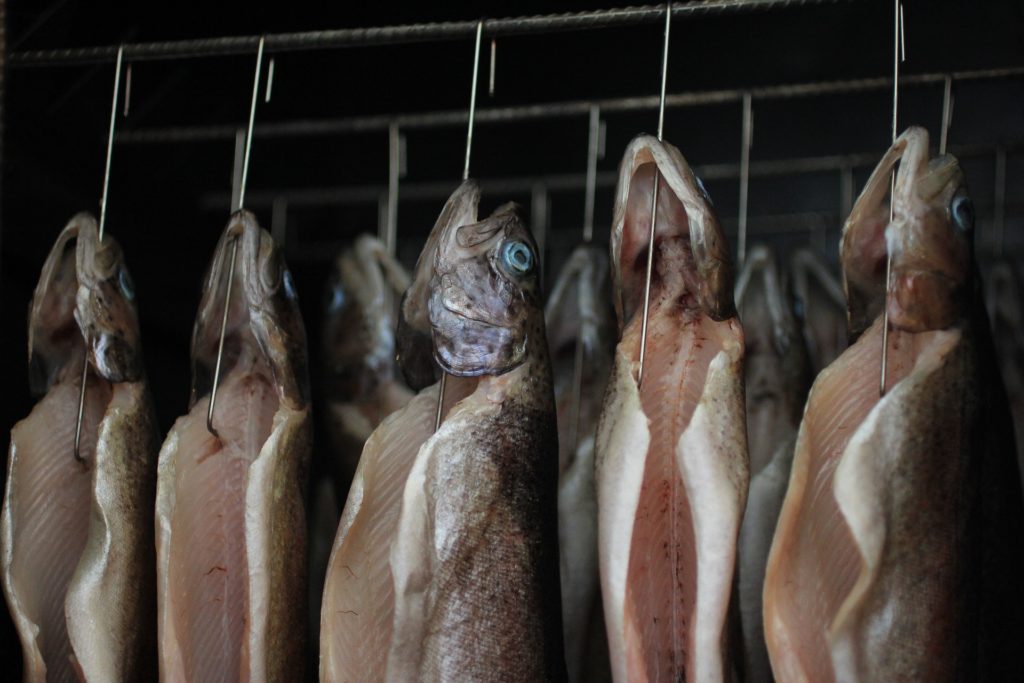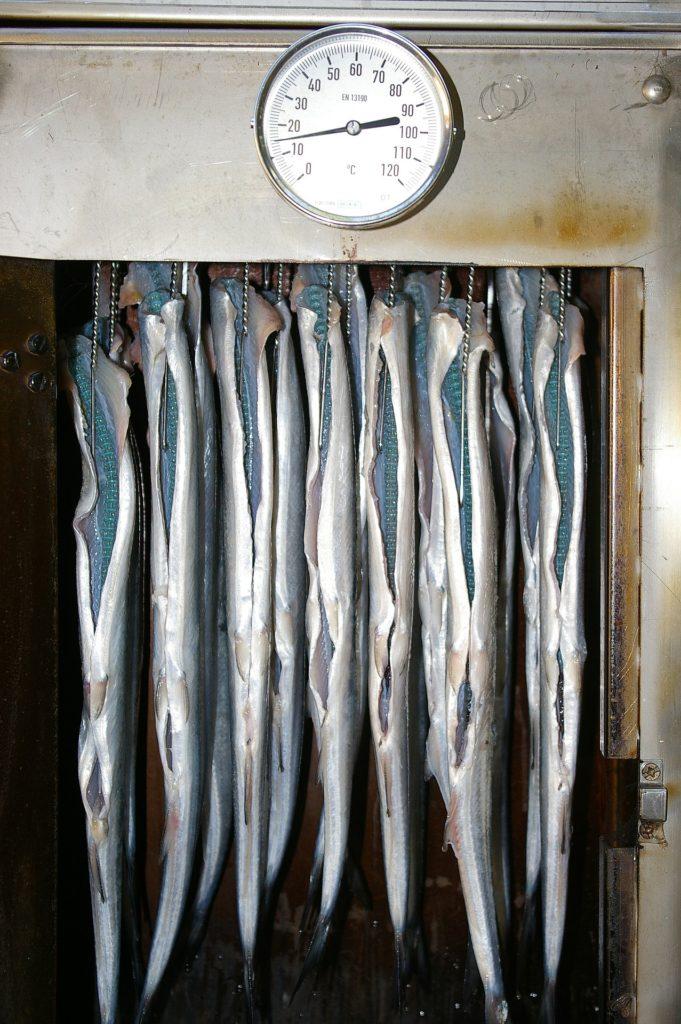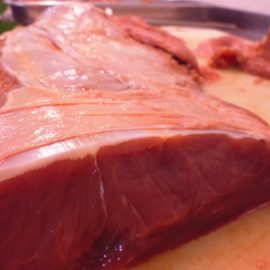
Smoking is one of the earliest forms of food preservation. Evidence suggests that our ancestors first smoked food during the Old Stone Age (Paleolithic Era). Back then, caves or huts were home to primitive cavemen. They would hang meat to dry inside. Once fire was discovered, caves would become smoky since they lacked a chimney. They later on discovered by accident that the smoke changed the flavor of the meat and that it preserved the meat better than simply drying the meat out. This procedure was eventually combined with pre-curing the food in salt or salty brine, creating a very efficient preservation technique.
Fish smoking first appeared incidentally when fishermen had to utilize open flames to dry their excess catch during wet or humid weather conditions rather than the sun and breeze. The microbicidal and antioxidant benefits of smoking were not fully understood until much later. Consumers developed a liking for smoked fish long before they were aware of it as a delicious substitute for eating fresh fish.
You might also like: Can You Really Eat Raw Hot Dogs?
Today, smoking can be used for a wide range of foods. Meats and fish are the most commonly smoked foods. In the cooler northern regions, common smoked fish include haddock and cod in Great Britain, herring in Holland and Germany, skipjack in Japan and smoked sturgeon in Norway, Scotland, and Russia. In the United States, mackerel, salmon, mackerel, trout, and white fish are commonly smoked.
Before we proceed with the discussion, let’s define what smoking is.
WHAT IS SMOKING?
Smoking is the process of exposing food to wood smoke. Smoke is an emulsion of droplets stabilized by electrostatic charges on the droplets in a continuous phase of air and vapors. The vapors in smoking are most significant for flavoring, coloring, and microbistatic functions.
Depending on the technique, various products can be concurrently cooked and smoked, cooked and dried, or smoked but not cooked. The source of smoke can be either by burning wood chips or using an approved liquid smoke preparation. It is also possible to employ liquid smoke preparations by adding them directly to the product during formulation rather than using a smokehouse or another sort of smoking vessel.
Smoking is frequently seen as a pretreatment instead of a drying method. The heat produced during smoking has a drying impact on food, even if it is not typically employed to do so. But the main benefits of the process are that it gives food appealing flavors and colors. Furthermore, some of the compounds created during the process have a preservative function because of the presence of many components. Acids, carbonyls, and phenolic chemicals are all present in smoke. And the phenolic compounds’ volatile nature is largely responsible for the flavor of smoke. More than 400 volatiles have been found in wood smoke, making it exceedingly complex.
It is worth-noting that although smoking helps preserve foods, it may not be sufficient as an antimicrobial treatment, especially for meat and fish products. This is because the smoke does not penetrate the flesh far enough. If this is the case, processors combine smoking with salt-curing or drying.
HOW SMOKING FISH IS DONE

The traditional method of smoking fish entails passing hot smoke from a variety of woods over the fish in order to partially dry the fish and impart the flavor and aroma of the smoke. The drawbacks of this are the lack of control over the process and the final product, as well as potential health risks if the fish’s surface is not adequately dried.
Modern fish smoking techniques include a variety of drying techniques to lower water activity on the surface and liquid smoke compositions to add taste. Before drying, the fish is submerged in smoke solutions. The majority of drying techniques employ heat to alter the air’s relative humidity as it passes over the fish. This wastes energy and also causes numerous aromatic chemicals that contribute to the product’s flavor, color, and aroma to be driven off by heat.
This can be avoided by utilizing a heat pump drier that uses less energy and dries items inside of a sealed chamber. There are two types of smoke solutions: condensed products from the dry distillation of wood and synthesized phenol mixes.
Utilizing smoke condensates has certain benefits. They are simple to use, and you can manage their concentration. They can be examined for antibacterial activity, studied, and purified if necessary. Synthetic smokes are more similar to actual smoke curing and can be made without dangerous ingredients. The nature of the wood has a significant impact on the smell, flavor component composition, and antibacterial activity of the smoke.
Wood for smoking fish
Wood is preferred to sawdust in many regions of the world. The fish is charred rather than smoked as a result of the hotter, less smoke-producing fire. In a sawdust fire, the air cannot easily reach the flames unless there is a forced quick flow, therefore the sawdust smolders rather than burns.
A smoke with more flavoring and preservation agents is produced at lower temperatures and with less oxygen. These compounds are wasted when they are oxidized into carbon dioxide and water at higher temperatures and with more oxygen. However, the majority of smoke used for smoking is still produced by a simple fire globally. Modern smoke producers feed sawdust gently onto an extremely hot surface.
You might also like: Meat Science: Does Marinating For Flavor Really Work?
The flavor of smoked fish depends on the sawdust’s species source. Hardwoods like oak, hickory, cherry, apple, and beech burn with higher phenols, which retain and give the product a distinctive, “medicated” flavor. It is questionable if a product that has been hickory smoked can be distinguished from one that has been similarly beech smoked, especially after the product has been cooled and stored.
There should caution when choosing wood for smoking fish. As per Codex Alimentarius, toxic substances must not be present in wood or other plant material used to generate smoke or smoke-condensates, either naturally or as a result of contamination, treatment with chemicals, paint, or impregnating agents.
Cold smoking vs. hot smoking
There are 2 methods of smoking fish: hot smoking and cold smoking.
In cold smoking, the fish is cured at an air temperature of 68 (20°C) to 86°F (30°C) for 6 and 24 hours to several weeks. Cold smoking produces fish that has a milder flavor than fish that has been hot smoked. Also, cold smoked fish, such smoked salmon, keeps the texture of raw fish while having less moisture content. Fish that is hot smoked is cooked and has a firm but flaky texture. Because microorganisms are not eliminated, salt curing is done before cold smoking.
It is advised to utilize prefrozen fish. This is to ensure that any parasitic worms or bugs that could not be killed during the procedure are truly killed. Industrial smoked products are typically smoked and brined less. Economically speaking, this is better because fish and meat are sold by weight.
One good example of commonly cold-smoked fish is salmon. The fish may be brined with salt (sometimes sugar) for a few hours to several days. This is then rinsed and air-dried prior to cold smoking for 5 to 35 hours.
Hot smoking, on the other hand, involves exposing fish to smoke and heat at 140°F (60°) to 176°F (80°C), usually in a smoker oven or smoker house. The rich and slightly darkened color of hot-smoked fish is partly caused by condensation of dark resins from the smoke and browning reactions between amino acids in the pellicle and the aldehydes in the smoke.
Hot smoking of fish involves five steps. These are surface drying, smoking, drying, heating/cooking, and cooling. Surface drying is the removal of moisture from the surface and leaving a protein coating (pellicle) on it in order for each piece of fish to absorb an uniform smoke deposit.
METHOD OF PRESERVATION
In most parts of the world, preservation is still the prime objective of smoking. Smoking preserves foods due to a combination of several factors.
Salting
Salting inhibits the growth of many spoilage organisms and pathogens by reducing the water activity of fish. Water activity is one of the factors that controls the rate of deterioration in food. It refers to the amount of unbound or free water available for microbiological reactions. To slow the rate of deterioration, the water activity should ideally be below 0.95.
For a more detailed discussion on water activity regarding food safety, refer to this post: Water Activity (aw) And Food Safety.
Nowadays, fish is “cured” first by salting or brining in salt concentrations of around 3% or so. This is not quite enough to prevent microbial activity, for a few hours to a few days. Instead, it draws proteins found in muscle fibers to the surface, where they dissolve in salt and form a gel-like sticky layer on the surface of the fish after it is dried and hung.
Deposition of phenolic antioxidant substances
Traditional smoking can extend the induction period of autoxidation from 4 days in unsmoked controls to roughly 50 days. Autooxidation is the spontaneous oxidation of a compound in air. This describes the gradual degradation of organic compounds in air. The phenolic antioxidants also delays the development of rancidity generally highly unsaturated fish lipids.
You might also like: 5 Reasons That Make Fish Highly Perishable
However, the antioxidant effect of smoking is primarily linked to the particle phase of wood smoke (the vapor phase exhibiting little to no antioxidant activity). And it increases with increasing temperature of the oxidation stage of smoke production while being unaffected by the temperature of pyrolysis (burning process) or air supply.
Deposition of antimicrobial substances
Wood smoke contains a variety of preservatives. Phenol and other phenolic chemicals have antioxidant and antibacterial properties. In fact, vaccine manufacturers use phenol to prevent bacteria from contamination vaccine solutions. Formaldehyde, acetic acid, and other carboxylic acids are examples of other antibacterial substances. Additionally, these substances are removed and used as liquid smoke.
Surface drying
As earlier mentioned, surface drying removes moisture from the surface of the fish, leaving a pellicle on it to absorb an uniform smoke deposit. Another benefit of surface drying is to provide a protective barrier against microbial passage and a hostile environment for any aerobic microbial proliferation.
FLAVOR AND COLOR DEVELOPMENT
Modern smoking techniques should aim to improve product shelf life while preventing the buildup of recognized carcinogens and to impart the required sensory attributes to the product evenly, without unnecessary variation from batch to batch.
You might also like: Meat Science: What Is Rigor Mortis?
Controlling the quality of the raw materials and process variables such brining treatment, smoking kiln time, temperature, and air speed has a significant impact on the appearance and texture of the smoked product. However, there is evidence to support the notion that some smoke components, such as formaldehyde, toughen the proteins in the muscles.
Flavor
Phenols are usually thought to have a significant part in the desirable characteristic flavor of smoked fish. Eugenol, syringaldehyde, acetosyringone, and acetovanillone appear to be more significant in hot-smoked fish, whereas guaiacol, maltol, phenol, and m-cresol are significant in cold-smoked fish.
Guaiacol is less significant than eugenol in what is thought to be a typical smoked flavor. Furan derivatives have a pleasant, fragrant perfume that is supposed to balance out the potent, smokey aromas of the phenolics in the lower boiling point portion of liquid wood smoke condensate.
Although the appetizing smoked fish flavor notes at low concentrations appear to be primarily caused by the low molecular weight fractions of wood smoke, higher concentrations are perceived as less appealing “burnt” or “phenolic” notes.
Color
The color that the smoking process gives fish is a result of Maillard-type carbonylamino reactions. These reactions have been linked to a quantitative drop in carbonyl groups in the smoke. Additionally, ribose from the breakdown of nucleotides and ribonucleic acids and free amino compounds like anserine and taurine in fish muscle extractives cause the surface of drying fish to brown. The extent of spoilage of fish also contributes to the extent of brown color formation. However, stale fish cannot be used to make good smoked goods. The freshness of the fish before it is smoked determines the quality of the product that is delivered to the customer.
References
V. Vaclavik, E. Christian (2014). Essentials of Food Science (4th edition). Springer.
M. Gibson (2018). Food Science and the Culinary Arts. Academic Press.
M. Shafiur Rahman (2007). Handbook of Food Preservation (2nd edition). CRC Press.
G.M. Hall (1997) Fish Processing Technology. Blackie Academic & Professional.
P. Fellows (2000). Food Processing Technology (2nd edition). CRC Press.


